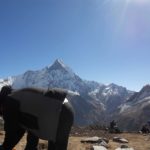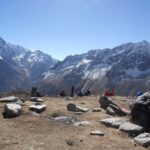

Tent Peak Climbing
- DURATION: 18 DAYS
-
Duration: 18 Days
-
Best Time: Autumn & Spring
-
Max Elevation: 5,663M
-
Group Size: Min 2
- Trip Grade: Moderate
Trip Highlights:
- Tent peak climbing experience
- Marvelous trekking adventure in the attractive Annapurna region and delve into the charm of the Annapurna Sanctuary
- Rainforest jungles and barren alpine rain shadow
- Wondrous sunrise and the Himalayan horizon from PoonHill with extraordinary visions from Annapurna Base Camp, Tharpu Chuli Peak
- Involvement in Gurung culture in the amiable village inn
- Close views of the mountain peaks
- Cultural excursion tour in Kathmandu
- Camping at the high elevation ahead of the South Annapurna iceberg
- Well scheduled itinerary throw out the risk of altitude sickness
An attractive stop for those pursuing an experience of mountain climbing in Nepal is Tharpu Chuli; one of the alluring peaks located in the core of Annapurna Sanctuary.
Nowadays, Tharpu Chuli is usually familiar as Tent Peak, named by its pioneer climber Jimmy Roberts in 1956. Tent Peak (5663m) identify as one of the topmost climbs in Nepal.
Tent peak climbing routinely linked with Annapurna base camp trekking, noticed to be the wonderland for its natural charm and dazzling mountain glimpse, marvelous landscape and many more.
During the time of trekking, we will observe an assortment of landscapes reclining side to side sub-tropical forest, plateau rice paddies, amusing rim, grassy countryside and forests of bamboo and rhododendron.
As the observation, Tent peak is a low height peak and one of the ideal peaks for having primary experience for climbing high peaks and also for adapting oneself for having summit to the topmost mountains notably above 8,000 meters. Tharpu Chuli, associated with Nepalese Himalayan range needs ice climbing pieces of equipment for the summit.
Physical Condition & Experience Requirements
Tent Peak also is ranked as 2C for mountain climbing and expedition. This means ropes, ice axe, and crampons need to be used during the climb. High level of fitness with good health condition is essential for this journey.
You do have previous climbing experience then it is great but if you don’t have then at least you should have ability to walk 6-7 hours a day.
When to go
Autumn from September to November and Spring from March to May are the finest period of time to trek in the Tent Peak. During this period of time, the sky is clear so we can get remarkable views of the mighty Himalayan vista. Although this trek can be undertaken during winter, the cold temperature might not be favorable for everyone.
Itinerary
Day 1 Arrival day in Kathmandu.
Day 2 Kathmandu sightseeing and preparation.
Day 3 Kathmandu to Pokhara (823m/2,700 ft), 6 hrs drive.
Day 4 Drive to Naya Pul and trek to Ghandruk (1,940m/6,360 ft), 5 - 6 hrs trek.
Day 5 Ghandruk to Chhomrong (2,170m/7,120 ft), 6 hrs.
Day 6 Chhomrong to Dobhan (2,600m/8,530 ft), 5 - 6 hrs.
Day 7 Dobhan to Deurali (3,230m/10,597 ft), 1 hr 30 min.
Day 8 Deurali to Machhapuchre Base Camp (3,700m/12,135 ft), 3 - 4 hrs.
Day 9 Acclimatization and preparation day.
Day 10 Machhapuchre Base Camp to Cave Camp (4,250m/13,943 ft), 5 - 6 hrs.
Day 11 Cave Camp to High Camp (5,200m/17,056 ft), 4 - 5 hrs.
Day 12 Summit Tent Peak (Tharpu Chuli), return to High Camp, 9 - 10 hrs.
Day 13 Tent Peak High Camp to Machapuchhre Base Camp, 4 - 5 hrs.
Day 14 Machapuchhre Base Camp to Bamboo (2,310m/7,575 ft), 6 - 7 hrs.
Day 15 Bamboo to Jhinu Dada (1,760m/5,770 ft), 6 - 7 hrs trek.
Day 16 Jhinu Dada to Naya Pul, drive to Pokhara, 6 hrs trek, 1 hr drive.
Day 17 Drive from Pokhara to Kathmandu, 6 hrs.
Day 18 Final departure.
Related Packages
- Group Size: Min 2
- Max Altitude 5,846M
- Group Size: Min 2
- Max Altitude 7,134M

Naya Kang Peak





